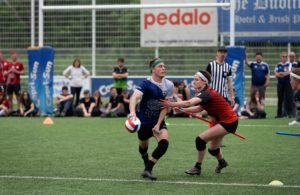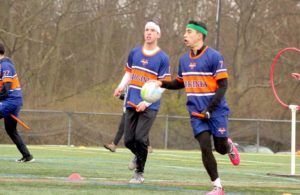- Rule, Britannia, no more?
- Unpopular Opinions: US Quadball Cup 2023
- Proven Contenders: University of Virginia
- Proven Contenders: Rutgers University
- Proven Contenders: University of Michigan
- Proven Contenders: Creighton University
- Different Perspectives: A Look Inside USA Ultimate
- Antwerp QC, Much of Belgian Core, Leaves Competitive Quidditch
The Nationals that Wasn’t
With the rapid, countrywide spread of COVID-19 that led to the postponement of USQ Cup 13, and with numerous US state and city governments issuing stay-at-home orders, quidditch withdrawal symptoms are at an all time high. While the degree of disruption that this coronavirus outbreak will cause is still uncertain–even among epidemiologists–there is no doubt that the postponement of USQ Cup 13 will decrease the attendance of some players or teams (UTSA has already announced that they would be unable to attend) and–should the worst happen and the tournament be cancelled altogether–nearly every team that had planned to attend would be left with a “what if?” to question the hypothetical outcome had this outbreak never struck.
In part to answer that question for the countless players that were left with an uncertain season conclusion, and in part because the vast majority of The Eighth Man staff are stuck on their couches with no nationals content to write, we are presenting US Quarantine Cup 13: A simulation of every matchup at USQ Cup 13 had it actually happened. Over the following two weeks, we will post results, interview team leaders and write recap articles based around our Elo-based simulation of how the tournament could have played out, giving teams at least a hypothetical glance at the end of their season.
To ensure there’s no bias to pick the “best narrative”, we have simulated 10 complete national tournaments–including 10 separate pool draws, anonymized them, and then put the vote to you. That way, when the inevitable upset occurs throughout our simulation–they’re predicted to occur just as frequently in our model as they do in real life–the public will share as much of the blame (or credit) in that result as we do. Based on the current simulations, we have three potential college champions and three potential club ones, so your vote in this will matter. To vote for which scenario’s results become our officially-posted content, please vote at this link. For the teams that inevitably pull the short end of the straw in our official scenario, we will be publishing brief recaps of the other nine scenarios after the fact as pseudo “consolation cups” for what could have been.
Furthermore, we would like our coverage of this “event” to be as realistic as possible and would love to reach out to team contacts when we publish our recap articles. If you are a member of leadership for your team, please fill out this form so that we can contact you for quotes and player names to highlight when recapping your team’s performance.
For those curious about the nuts and bolts of how this simulation is going to run, we will be using a new game simulator programmed by Elo Editor Joshua Mansfield. While this program will still use a team’s Elo ranking as input, it will not simply use that ranking to provide a probabilistic output of how likely they are to win the game. Instead, based on a regression analysis of Elo ratings and score differentials from the past six national tournaments, the simulator will create a probabilistic score differential for every “game” that is simulated (for the true stats geeks, that formula predicts that a difference of roughly 55 Elo points is worth roughly 10 points toward a team’s quaffle differential, with a quaffle point standard deviation of nearly 45). In practicality, that means a team who is 220 Elo points greater than their opponent is predicted to win by 40 quaffle points, but has a 68 percent chance (one standard deviation) of finishing with between -5 and 85 quaffle points greater than their opponent. In-range snitch catches are treated as a coinflip in this simulation and catching the snitch when the opponent is out of range is ignored for the sake of results. Once the point differential is determined, some unpublished scorigami-like quidditch data is used in a formula to spit out a realistic–and now “official”–game score. For those interested in the code behind how all of this is calculated, please check out the source code (and small hypothetical round-robin simulator) here. Several gameplay assumptions were made, including:
- Each flight could have no more than three teams from the same region
- Teams from the same region could not play each other in the first round of flight play
- The first college tiebreaker was record in first two games (teams who went 2-1 from being 2-0 were seeded higher than teams who went 2-1 from being 1-1)
- Each pool could have no more than two teams from the same region
- Club bracket would be preseeded to minimize pool rematches (same format as QC12)
Finally, for the sake of this analysis alone–not our official Elo ratings)–unofficial results from the Atlantic Challenge will be entered into our Elo algorithm at half weight, to help make up for some of the predictivity we missed out on in the last month of potential games.
About Joshua Mansfield
A native of Cincinnati, Ohio, Joshua Mansfield began playing quidditch when he founded the Tulane University team in 2013. He currently plays for Texas Hill Country Heat and serves as the Gameplay Director for Major League Quidditch. Additionally, he is the third-largest consumer of cilantro in the greater New Orleans area.




One Comment